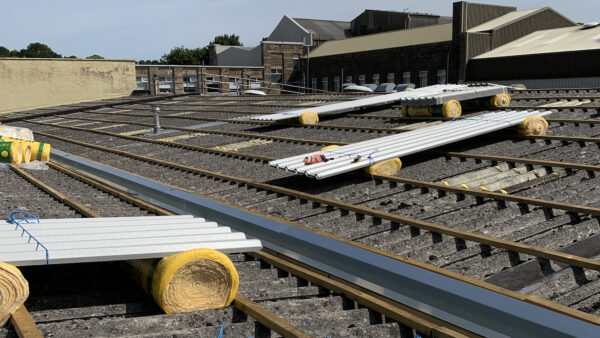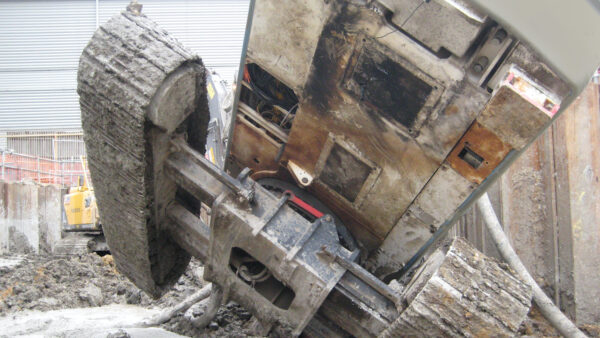
The new £23m facility means that the Bow Back rivers, formerly tidal, are now navigable 24 hours a day
As the Olympic Park struggles to make full use of its waterways, now it’s up to Crossrail to rekindle interest in this sustainable transport method. Elaine Knutt reports. Photographs by Oliver Knight.
The Ursula Katherine is a lonely pioneer. The barge makes a weekly trip to collect waste packaging from the Olympic site for transport to Tilbury in Essex, passing through the new Three Mills Lock. Purpose-built to turn the previously tidal Bow Back Rivers into a navigable transport artery linked to the Thames, the £23m facility opened last August.
But the automated lock gates will open and close just for her, the crew won’t be hailing other bargees on the route, and she’ll make the return trip upriver with only ballast in her hold.
In the past six months, just 5,000 tonnes of Olympic waste and materials have moved through the lock, while up to 8,000 tonnes arrive by train every day.
As is widely known, the Olympic Delivery Authority’s (ODA) sustainable transport strategy targeted moving 50% of materials in and out of the park by rail or water. In fact, an impressive 63.5% has so far been shifted off the roads.
But the Olympic contractors’ enthusiasm for rail freight has starved the waterways of the attention needed to get to grips with its lead times and logistics. The A12 is congestion free and carbon emissions have been cut – but it’s hard to argue that the long-term interests of sustainable transport have been served.
To the waterfreight industry, keen to demonstrate that the UK’s inland waterways can return to their historic role as construction freight motorways (see box on page 19), it’s a familiar tale of promises dispelled. In the past decade, a string of prominent waterside developments, such as Paddington Basin, have turned their back on the sustainable transport assets that adorn their marketing brochures. “We needed a big, credible organisation to do it for everyone else to think that it’s okay,” says Gerald Hewden, commercial director of barge operator Wood, Hall & Heward. “We hoped the Olympics would do that, but it hasn’t fulfilled that role.”
The arguments for a “modal shift” onto inland waterways combine the environmental and the emotional, hard facts on carbon emissions and softer issues such as the promise of revitalising once-vibrant waterways. Waterfreight is “sustainable” as a less carbon-intensive alternative to road freight (in terms of tonne per km), with the emissions benefits rising with the length of the journey, and also reduces congestion on our roads. And it’s also sustainable in terms of national resource efficiency: clearly it makes sense to use the capacity of an existing transport infrastructure before we think about building new roads.
To some extent, the Olympic contractors’ reluctance to take up the waterfreight option is linked to specific difficulties on the local waterways. Most critically, Three Mills Lock was delivered 10 months late by British Waterways, allowing a road-and-rail mindset to become entrenched. The ODA did dredge the waterway upstream of the lock and complete a wharf on the Olympic Park, but only after the lock had opened. Meanwhile, a sewage pipe elevated above the canal restricts the height of the loaded barges, and a tricky tight corner restricts their size to 100 tonnes.
Cultural resistance
But in other regards, the failure of a sustainable waterside Olympics to promote sustainable waterborne transport is linked to the same cultural resistance that has stood in the way elsewhere. Where the necessary loading and marshalling infrastructure exists – as at the Olympics – there tends to be cost neutrality between water and road transport, and little economic incentive to switch. And although the sustainability advantages are clear, these aren’t yet enshrined in BREEAM assessments, contractual terms or client expectations.
Ray Payne, the ODA’s head of logisitics, admits it is a “shame” that the Olympic construction programme has so far failed to leverage the kind of shift that would ripple down the Thames to the Trent, Severn and Mersey. “We’ve had industry days, we’ve advertised the advantages to Tier One contractors of using water, but it’s up to them to decide. It has to be a balance between reducing the carbon content of the transport route and the economics. To a large extent, the construction is driven by economic factors, because the taxpayer is paying for the Olympics.”
And he defends the “rail or water” policy, arguing that the ODA could not have incentivised water without upsetting the level competitive playing field that rail and road freight operators are entitled to enjoy. “We can’t support any one sector with incentives for fairly obvious reasons,” he says.
British Waterways’ sustainable transport manager Kim Milnes hopes the final chapter on water freight at the Olympic Park has still to be written. “People aren’t prepared to take risks with a waterway that isn’t proven. But people will become more aware of the waterways, and will start to look into it,” he predicts.
Towards the end of this year, the beginning of the fit-out phase will coincide with a reduction in capacity at the DB Schenker rail terminal, as part of its site is destined to be incorporated into the Olympic Village. Payne also predicts an upturn in water freight, although he cites a fairly modest traffic level of perhaps two barges a week of materials going in. Realistically, however, the multiple smaller palletised loads ordered by contractors for the fit-out stages will fit more easily on the back of a lorry.
If the Olympics has fumbled the baton on promoting a waterfreight revival, all eyes are now on the next big publicly-funded project off the blocks. The Crossrail tunnellling team has the task of shifting approximately 7.3m m3 of excavated material for recycling as aggregate or to regeneration sites in Essex and Kent. Then it has to deliver thousands of concrete tunnel sections to line the newly-formed tunnels to two tunnelling sites, in Westbourne Park and Docklands (see box below).
The client’s logistics team, headed by Simon Phillips, has drafted outline plans to fulfil a commitment in the Crossrail Bill to minimise road congestion and maximise rail and water freight. Phillips has also commissioned a feasibility study from consultant Peter Brett Associates to use the Slough-to-London Grand Union Canal to transport tunnel linings to Westbourne Park. However, the final decision on this aspect of the scheme depends on where the linings are cast, which in turn is the decision of the yet-to-be-appointed tunnelling consortium.
Natural synergies
So far, at least, it looks as if Crossrail has recognised the natural synergies that often exist between water freight and construction. Where construction is preceded by demolition or excavation, water freight is clearly an appealing alternative to putting multiple HGVs of muck-away on the roads. Much of the industry’s imported materials – such as cladding from the continent, or stone from China – already arrives at one of the UK’s 100 coastal ports. From there, loading onto a river-barge is no more problematic than to an HGV.
Construction shifts bulk loads of sand and aggregate, heavy loads of steel and timber, all readily accommodated on river freight barges with a capacity of between 100 and 1,000 tonnes. And where storage capacity is a problem, holding materials on the water until needed can be a cost-effective option.
While water freight is clearly slower than the alternatives, it’s no less reliable. “In terms of predictability, we’re better – there’s no congestion,” says Heward.
And while canals did freeze in the recent post-Christmas cold snap, it’s not as if the road and rail industries can claim superiority. As a further inducement, the water freight industry is currently dealing
with an increase in capacity due to the decrease in municipal waste. In London, the barge fleets that have been carrying the capital’s waste from Battersea to landfill in Essex now have plenty of spare capacity.
But as a £16bn heavyweight, Crossrail also has a major advantage over smaller projects, according to Gary Sullivan, managing director of logistics company Wilson James. Sullivan has looked at the water freight option for several clients planning waterside developments in London, but always concluded that the financial barriers were just too high.
“Whilst it’s a fantastic idea, it’s hugely expensive in terms of building a jetty or wharf,” says Sullivan. “On a mega-project, you can absorb the costs, but it’s not so easy if you’re building houses. If it’s difficult to make it financially viable in the good years, it’ll be a major struggle now.”
As Sullivan says, building or upgrading the necessary infrastructure can represent a high cost. The goods’ journey may originate at a port, in which case a fee will be charged for using its loading facilities. If the freight is to be assembled elsewhere, as with Crossrail, then a suitable waterside loading wharf must be found, built or leased from a private company. At the destination, there must also be suitable unloading facilities. “There is military hardware that allows you to unload without a wharf or jetty, but it’s not so easy for a Balfour Beatty to get hold of,” adds Sullivan.
But decades of under-use of the inland waterways, followed by a decade of enthusiastic waterside residential development, mean that the inland waterways network has only a fraction of of the wharves, jettys and marshalling areas it once had. “Land space is at such a premium, the places where we used to load have gradually got built on, so we’re being squeezed out,” says Heward.
To help bridge that gap, there are two forms of government funding available. First, the capital costs of building or upgrading a wharf may attract a grant. Three Mills Lock benefited from this, as did waste recyling firm Powerday when it built its canalside facilities at Willesden in north West London. Then there’s the Freight Facilities Grant, operated by the Department for Transport. “If the cost by road is £10 a tonne, and the cost by barge is £11.50, you can apply for a top-up grant of £1.50 a tonne,” says John Dodwell, chief executive of the Commercial Boat Operators Association (CBOA). “It’s a useful step forward, but the government doesn’t seem to be publicising it,” he adds.
But for today’s construction sector, the carbon-based arguments are likely to be most compelling. Tugs and barges run on diesel engines, just like the HGV wagons clogging our roads. “Barge engines are roughly 30-40 horsepower, and a modern lorry is around 350hp, so fuel consumption and carbon emissions are proportionately much less,” says Heward. In one example cited by lobby group Freight by Water, an HGV carrying 25 tonnes burns 0.5 litres of diesel per kilometre. A river barge capable of carrying up to 1,000 tonnes – or 40 lorry loads – burns 5 litres of diesel. Expressed against freight capacity, the river barge is 2.5 times more fuel efficient.
However, these advantages aren’t yet reflected in BREEAM, the Code for Sustainable Homes, construction contracts or public sector tender documents. As for BREEAM 2008, BRE marketing manager Simon Guy explains that projects using water freight could apply for an “innovation” credit. However, the timing could be right to revisit the issue. “We update BREEAM bi-annually, and the next review starts at Ecobuild. If people are saying we need to address the issue of transport to and from sites, then that’s the purpose of having regular feedback.”
But the CBOA’s Dodwell believes it is local authorities that really have the power to shift behaviour, as happened with micro-generation and the Merton Rule. For instance, the London Borough of Tower Hamlets has stipulated in the planning permission for the Wood Wharf mixed-use development in Docklands that aggregates for the concrete frame must be shipped by barge. “Some ask for a feasibility study but then clients commission a study to prove it’s not economic. We need more than just lip-service,” says Dodwell. Milnes agrees.
“If government wishes people to use water, then they should write that into the tender documents for public sector projects – in other words, show the way. Just as people have had to price and understand rail freight, they’ll learn to understand water.”
However, there are projects where all the barriers have come down and barges have sailed smoothly through. Paul Eccles, project manager for Bovis Lend Lease on MediaCityUK, the BBC’s new Salford home, describes bringing 400 containers of stonework and other materials up the Manchester Ship Canal from Liverpool as cost-effective. “To make it viable, we needed about ten 25-tonne containers on each barge. The day rate for a mobile crane to unload them was £1,000, but hiring an HGV for the round trip by road would be £200 per container,” he says. When Bovis studied the carbon footprint of water versus road, the saving worked out at 53 tonnes of CO2 per container.
The client for MediaCityUK is Peel Media, a subsidiary of Peel Group, the company which in fact owns Mersey Docks and the Manchester Ship Canal. It was already running a regular freight service along the canal, meaning that Bovis did not have to contract its own barge operator. “They gave us the right cost [for haulage]. They want to use the canal more, it’s in their interests to keep it competitive,” says Eccles. As fit-out progresses, he will be looking at bringing more materials in by barge. “The governing factor is where the materials originate, but with most imported goods, there is a [water freight] opportuntity.”
In London, contractor Sir Robert McAlpine used barge company Wood Hall & Heward and the Regent’s Canal to deliver and store materials for the award-winning King’s Place development after the London Borough of Camden refused it a licence to unload from the road. Originally, the arrangement was set up to deliver steel beams for the superstructure. “But after McAlpine set up the system, each subsequent contractor followed suit,” says Hewden.
As Crossrail gets under way, there are other riverside projects in the pipeline that could help shift the industry’s mindset from its default “road” setting. Three Mills Lock could yet deliver a return on the public investment by facilitating water freight traffic linked to the Thames Tideway Tunnel project, the legacy phase of the Olympic Park, and the 15-year mixed-use development programme at Stratford City. At King’s Cross, Argent is said to be looking at emulating the experience at nearby King’s Place. Further in the future, a usable wharf already exists at Battersea Power station.
It won’t be easy for construction and the water freight industry to forge a sustainable partnership in the future. Underlying the problems at the Olympic Park – and threatening the vision of a watery future for Crossrail – is the lack of communication between the two industries and a lack of policy and legislative drivers. But if it can be done, the construction industry could squeeze more carbon out of the sector, contribute to the long-term sustainability of our transport infrastructure, and help return the waterways to the vibrancy they used to know. If the upfront cost is a just feasibility study, surely it’s a price worth paying?
A brief history of canals
Before the advent of road and rail, canals were Britain’s principal transport system, and they provided a vital means of getting construction materials to building sites. The earliest examples of using canals to move building materials date back to medieval times, when stone required to build cathedrals was transported by barge.
One of the UK’s most impressive abbeys, Rievaulx Abbey in north east Yorkshire, was built this way, serviced by a series of canals created sometime during the 12th and 13th centuries.
In the 14th century York Minster was erected with stone shipped via Bishop’s Dyke, which ran between Huddleston quarry and the River Ouse at Cawood near York. The transshipment of stone during this period is well documented, but it’s also likely that timber would have been moved via canal.
It wasn’t until the mid-1700s that canal building really took off in the UK and new waterways were vital to underpinning the success of the industrial revolution, allowing the faster movement of goods and commodities. The first waterway of this “canal age” was Sankey Brook, dug in 1757, followed in 1761 by the Bridgewater Canal, built by the Duke of Bridgewater to carry coal from his mines at Worsely to the markets of Manchester.
Canal boats would now carry anything from bricks and lime, needed to make mortar, to timber and cast iron. Bath was a popular destination, with its famous stone taken from quarries in the surrounding hills and moved via tramways running down the hills to the canal wharf, for shipment to destinations such as Bristol and London.
Most of the materials were carried in 2.1m-wide narrow boats, designed to fit through the thin canal locks and low tunnels common in the Midlands (it was cheaper to build narrower canals there), and each one could carry up to 25 tonnes inside a 40ft hold.
Throughout the 19th century cement was transported by canal, as well as iron manufactured at the hundreds of ironworks built alongside canals. During this period the Houses of Parliament, completed in 1840, was built using limestone dug from quarries in Derbyshire and transported via the Chesterfield Canal to Hull, then on to London.
However, the 19th Century also marked the arrival of the first railways, and many believe it was this new mode of transport that killed off freight on the canals.
It is true that the railways acquired many canal companies for reasons of self-interest, but freight carrying continued on canals until after the Second World War and it was actually competition from the new motorways, compounded by the terrible winter of 1962/63, that did for most freight on the waterways. Indeed, canals may have helped contribute towards their own demise as they ferried much of the aggregate required to build the motorways.
With thanks to engineering historian Malcolm Tucker and London’s Canal Museum.










